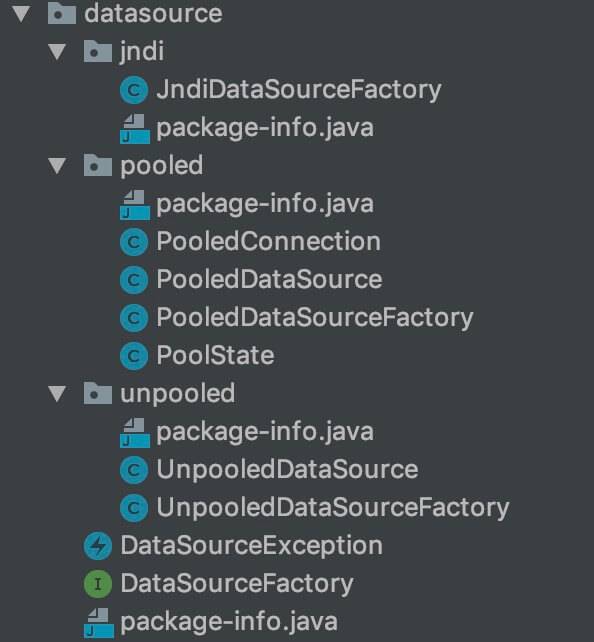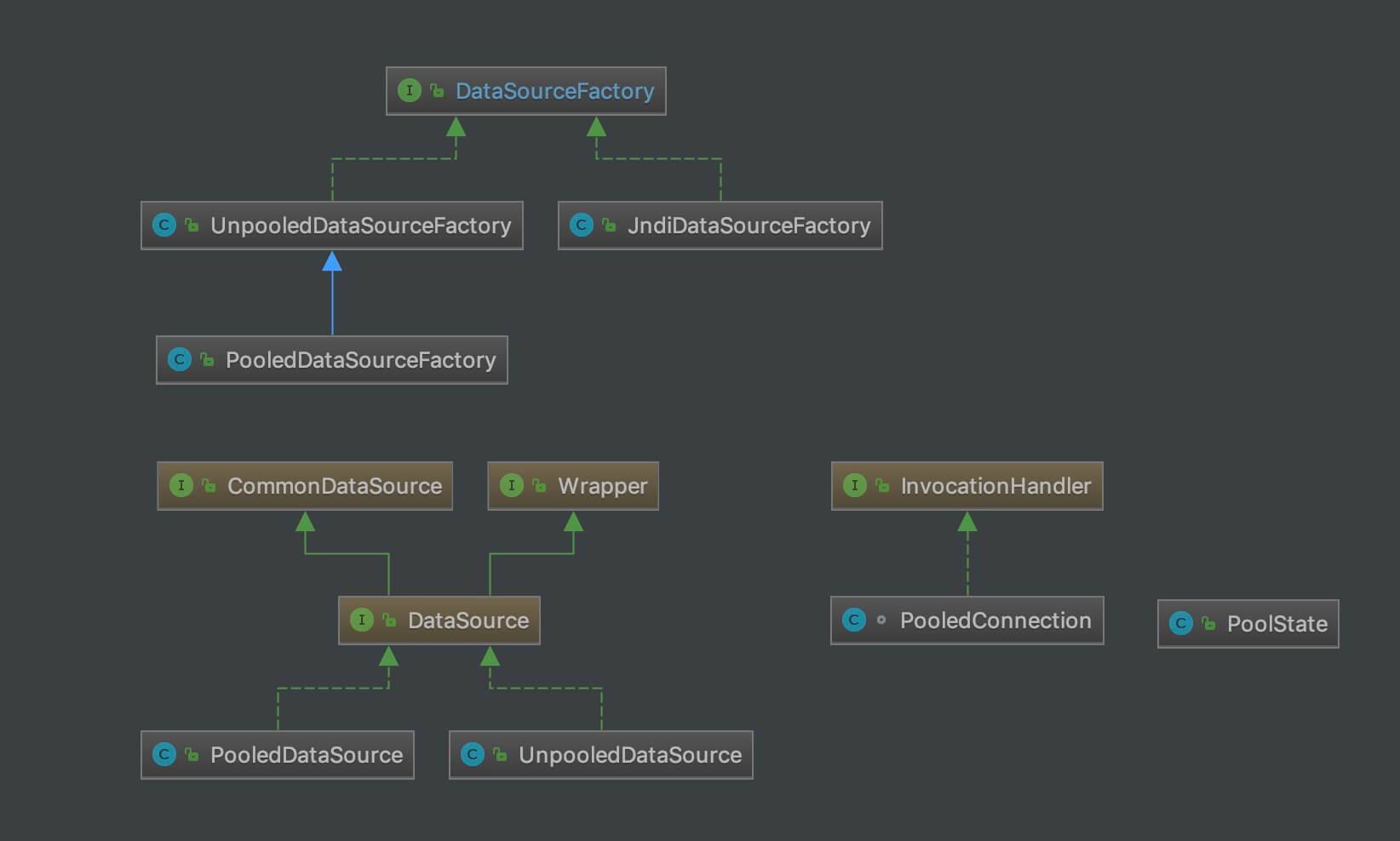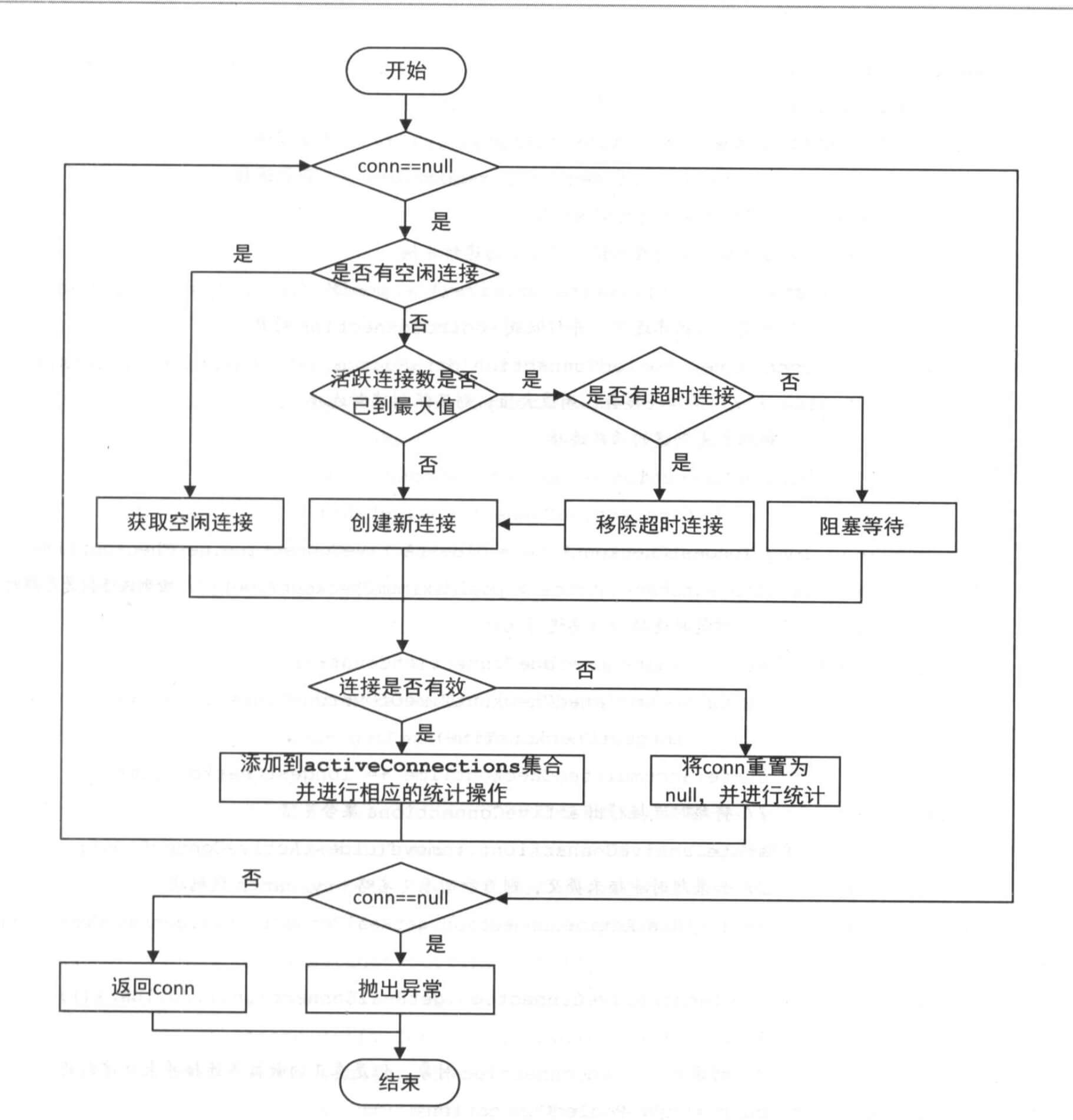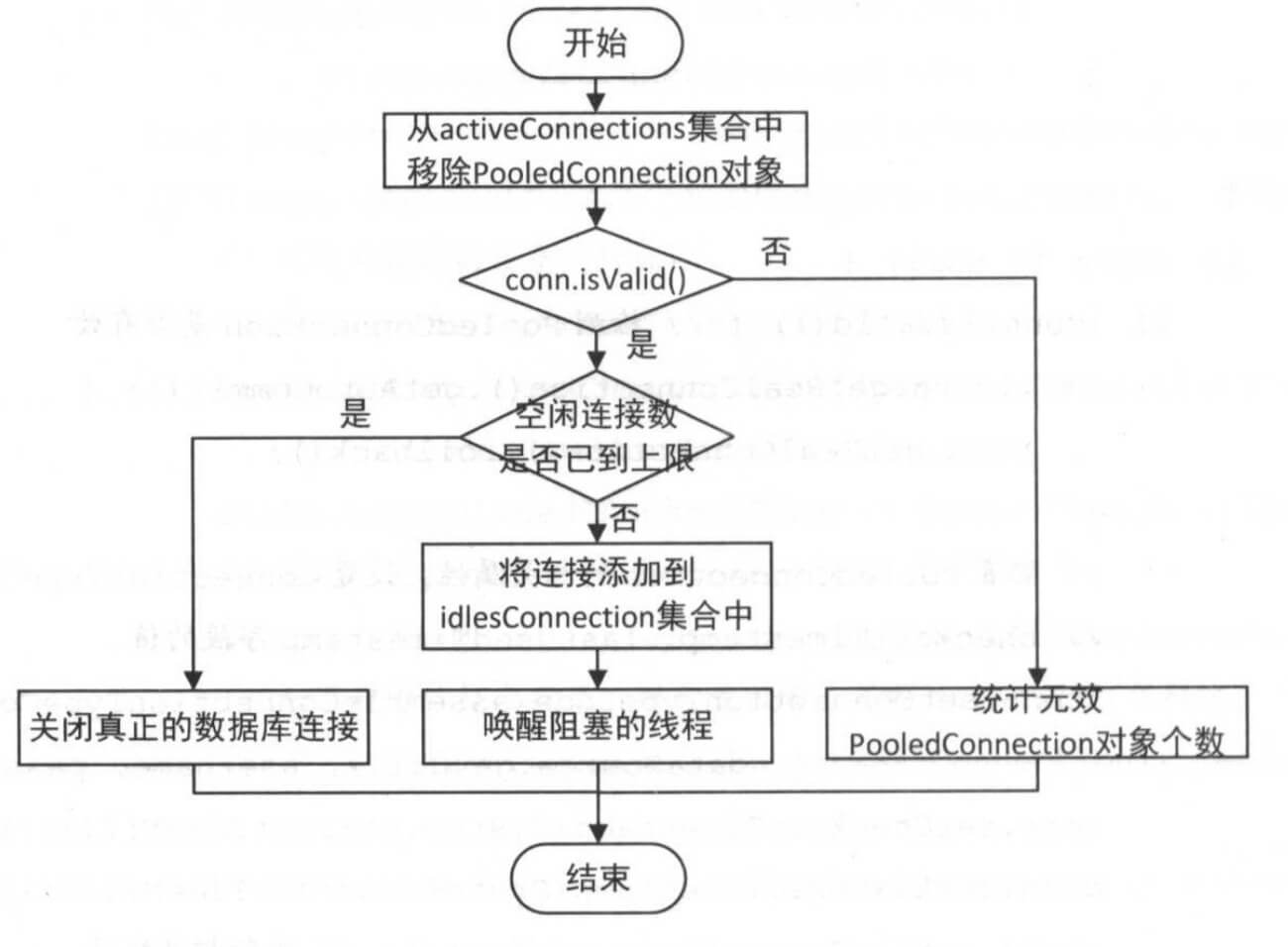MyBatis源码分析(六):数据源模块
1. 概述
本文,我们来分享 MyBatis 的数据源模块,对应?datasource?包。如下图所示:
在?MyBatis源码分析(二):项目结构?中,简单介绍了这个模块如下:
数据源是实际开发中常用的组件之一。现在开源的数据源都提供了比较丰富的功能,例如,连接池功能、检测连接状态等,选择性能优秀的数据源组件对于提升 ORM 框架乃至整个应用的性能都是非常重要的。
MyBatis?自身提供了相应的数据源实现,当然 MyBatis 也提供了与第三方数据源集成的接口,这些功能都位于数据源模块之中。
本文涉及的类如下图所示:
下面,我们就一起来看看具体的源码实现。
2. DataSourceFactory
org.apache.ibatis.datasource.DataSourceFactory?,javax.sql.DataSource?工厂接口。代码如下:
2.1 UnpooledDataSourceFactory
org.apache.ibatis.datasource.unpooled.UnpooledDataSourceFactory?,实现 DataSourceFactory 接口,非池化的 DataSourceFactory 实现类。
UNPOOLED– 这个数据源的实现只是每次被请求时打开和关闭连接。虽然有点慢,但对于在数据库连接可用性方面没有太高要求的简单应用程序来说,是一个很好的选择。 不同的数据库在性能方面的表现也是不一样的,对于某些数据库来说,使用连接池并不重要,这个配置就很适合这种情形。UNPOOLED 类型的数据源仅仅需要配置以下 5 种属性:
driver?– 这是 JDBC 驱动的 Java 类的完全限定名(并不是 JDBC 驱动中可能包含的数据源类)。url?– 这是数据库的 JDBC URL 地址。username?– 登录数据库的用户名。password?– 登录数据库的密码。defaultTransactionIsolationLevel?– 默认的连接事务隔离级别。作为可选项,你也可以传递属性给数据库驱动。要这样做,属性的前缀为“driver.”,例如:
driver.encoding=UTF8这将通过?
DriverManager.getConnection(url,driverProperties)?方法传递值为?UTF8?的?encoding?属性给数据库驱动。
2.1.1 构造方法
// UnpooledDataSourceFactory.java
/**
* DataSource 对象
*/
protected DataSource dataSource;
public UnpooledDataSourceFactory() {
// 创建 UnpooledDataSource 对象
this.dataSource = new UnpooledDataSource();
}
- 默认创建了 UnpooledDataSource 对象。
2.1.2 getDataSource
#getDataSource()?方法,返回 DataSource 对象。代码如下:
// UnpooledDataSourceFactory.java
@Override
public DataSource getDataSource() {
return dataSource;
}2.1.3 setProperties
#setProperties(Properties properties)?方法,将?properties?的属性,初始化到?dataSource?中。代码如下:
// UnpooledDataSourceFactory.java
@Override
public void setProperties(Properties properties) {
Properties driverProperties = new Properties();
// 创建 dataSource 对应的 MetaObject 对象
MetaObject metaDataSource = SystemMetaObject.forObject(dataSource);
// 遍历 properties 属性,初始化到 driverProperties 和 MetaObject 中
for (Object key : properties.keySet()) {
String propertyName = (String) key;
// 初始化到 driverProperties 中
if (propertyName.startsWith(DRIVER_PROPERTY_PREFIX)) { // 以 "driver." 开头的配置
String value = properties.getProperty(propertyName);
driverProperties.setProperty(propertyName.substring(DRIVER_PROPERTY_PREFIX_LENGTH), value);
// 初始化到 MetaObject 中
} else if (metaDataSource.hasSetter(propertyName)) {
String value = (String) properties.get(propertyName);
Object convertedValue = convertValue(metaDataSource, propertyName, value); // <1> 转化属性
metaDataSource.setValue(propertyName, convertedValue);
} else {
throw new DataSourceException("Unknown DataSource property: " + propertyName);
}
}
// 设置 driverProperties 到 MetaObject 中
if (driverProperties.size() > 0) {
metaDataSource.setValue("driverProperties", driverProperties);
}
}<1>?处,调用?#convertValue(MetaObject metaDataSource, String propertyName, String value)?方法,将字符串转化成对应属性的类型。代码如下:-
// UnpooledDataSourceFactory.java private Object convertValue(MetaObject metaDataSource, String propertyName, String value) { Object convertedValue = value; // 获得该属性的 setting 方法的参数类型 Class<?> targetType = metaDataSource.getSetterType(propertyName); // 转化 if (targetType == Integer.class || targetType == int.class) { convertedValue = Integer.valueOf(value); } else if (targetType == Long.class || targetType == long.class) { convertedValue = Long.valueOf(value); } else if (targetType == Boolean.class || targetType == boolean.class) { convertedValue = Boolean.valueOf(value); } // 返回 return convertedValue; }
2.2 PooledDataSourceFactory
org.apache.ibatis.datasource.pooled.PooledDataSourceFactory?,继承 UnpooledDataSourceFactory 类,池化的 DataSourceFactory 实现类。
POOLED– 这种数据源的实现利用“池”的概念将 JDBC 连接对象组织起来,避免了创建新的连接实例时所必需的初始化和认证时间。 这是一种使得并发 Web 应用快速响应请求的流行处理方式。
除了上述提到 UNPOOLED 下的属性外,还有更多属性用来配置 POOLED 的数据源:
poolMaximumActiveConnections?– 在任意时间可以存在的活动(也就是正在使用)连接数量,默认值:10poolMaximumIdleConnections?– 任意时间可能存在的空闲连接数。poolMaximumCheckoutTime?– 在被强制返回之前,池中连接被检出(checked out)时间,默认值:20000 毫秒(即 20 秒)poolTimeToWait?– 这是一个底层设置,如果获取连接花费了相当长的时间,连接池会打印状态日志并重新尝试获取一个连接(避免在误配置的情况下一直安静的失败),默认值:20000 毫秒(即 20 秒)。poolMaximumLocalBadConnectionTolerance?– 这是一个关于坏连接容忍度的底层设置, 作用于每一个尝试从缓存池获取连接的线程. 如果这个线程获取到的是一个坏的连接,那么这个数据源允许这个线程尝试重新获取一个新的连接,但是这个重新尝试的次数不应该超过?poolMaximumIdleConnections?与?poolMaximumLocalBadConnectionTolerance?之和。 默认值:3 (新增于 3.4.5)poolPingQuery?– 发送到数据库的侦测查询,用来检验连接是否正常工作并准备接受请求。默认是“NO PING QUERY SET”,这会导致多数数据库驱动失败时带有一个恰当的错误消息。poolPingEnabled?– 是否启用侦测查询。若开启,需要设置?poolPingQuery?属性为一个可执行的 SQL 语句(最好是一个速度非常快的 SQL 语句),默认值:false。poolPingConnectionsNotUsedFor?– 配置 poolPingQuery 的频率。可以被设置为和数据库连接超时时间一样,来避免不必要的侦测,默认值:0(即所有连接每一时刻都被侦测 — 当然仅当 poolPingEnabled 为 true 时适用)。
- PooledDataSource 比 UnpooledDataSource 的配置项多很多。
代码如下:
// PooledDataSourceFactory.java
public class PooledDataSourceFactory extends UnpooledDataSourceFactory {
public PooledDataSourceFactory() {
this.dataSource = new PooledDataSource();
}
}- 默认创建了 PooledDataSource 对象。
其它方法,在父类中 UnpooledDataSourceFactory 中已经实现。所以,真正的池化逻辑,在 PooledDataSource 对象中。
2.3 JndiDataSourceFactory
org.apache.ibatis.datasource.jndi.JndiDataSourceFactory?,实现 DataSourceFactory 接口,基于 JNDI 的 DataSourceFactory 实现类。
JNDI?– 这个数据源的实现是为了能在如 EJB 或应用服务器这类容器中使用,容器可以集中或在外部配置数据源,然后放置一个 JNDI 上下文的引用。这种数据源配置只需要两个属性:
initial_context?– 这个属性用来在 InitialContext 中寻找上下文(即,initialContext.lookup(initial_context))。这是个可选属性,如果忽略,那么 data_source 属性将会直接从 InitialContext 中寻找。data_source?– 这是引用数据源实例位置的上下文的路径。提供了 initial_context 配置时会在其返回的上下文中进行查找,没有提供时则直接在 InitialContext 中查找。和其他数据源配置类似,可以通过添加前缀“env.”直接把属性传递给初始上下文。比如:
env.encoding=UTF8这就会在初始上下文(InitialContext)实例化时往它的构造方法传递值为?
UTF8?的?encoding?属性。
2.3.1 构造方法
// JndiDataSourceFactory.java
private DataSource dataSource;
- 不同于 UnpooledDataSourceFactory 和 PooledDataSourceFactory ,
dataSource?不在构造方法中创建,而是在?#setProperties(Properties properties)?中。
2.3.2 getDataSource
#getDataSource()?方法,返回 DataSource 对象。代码如下:
// JndiDataSourceFactory.java
@Override
public DataSource getDataSource() {
return dataSource;
}2.3.3 setProperties
#setProperties(Properties properties)?方法,从上下文中,获得 DataSource 对象。代码如下:
// JndiDataSourceFactory.java
public static final String INITIAL_CONTEXT = "initial_context";
public static final String DATA_SOURCE = "data_source";
public static final String ENV_PREFIX = "env.";
@Override
public void setProperties(Properties properties) {
try {
InitialContext initCtx;
// <1> 获得系统 Properties 对象
Properties env = getEnvProperties(properties);
// 创建 InitialContext 对象
if (env == null) {
initCtx = new InitialContext();
} else {
initCtx = new InitialContext(env);
}
// 从 InitialContext 上下文中,获取 DataSource 对象
if (properties.containsKey(INITIAL_CONTEXT)
&& properties.containsKey(DATA_SOURCE)) {
Context ctx = (Context) initCtx.lookup(properties.getProperty(INITIAL_CONTEXT));
dataSource = (DataSource) ctx.lookup(properties.getProperty(DATA_SOURCE));
} else if (properties.containsKey(DATA_SOURCE)) {
dataSource = (DataSource) initCtx.lookup(properties.getProperty(DATA_SOURCE));
}
} catch (NamingException e) {
throw new DataSourceException("There was an error configuring JndiDataSourceTransactionPool. Cause: " + e, e);
}
}-
<1>?处,调用?#getEnvProperties(Properties allProps)?方法,获得系统 Properties 对象。代码如下:
3. DataSource
javax.sql.DataSource?是个神奇的接口,在其上可以衍生出数据连接池、分库分表、读写分离等等功能。
3.1 UnpooledDataSource
org.apache.ibatis.datasource.unpooled.UnpooledDataSource?,实现 DataSource 接口,非池化的 DataSource 对象。
3.1.1 构造方法
// UnpooledDataSource.java
/**
* 已注册的 Driver 映射
*
* KEY:Driver 类名
* VALUE:Driver 对象
*/
private static Map<String, Driver> registeredDrivers = new ConcurrentHashMap<>();
/**
* Driver 类加载器
*/
private ClassLoader driverClassLoader;
/**
* Driver 属性
*/
private Properties driverProperties;
/**
* Driver 类名
*/
private String driver;
/**
* 数据库 URL
*/
private String url;
/**
* 数据库用户名
*/
private String username;
/**
* 数据库密码
*/
private String password;
/**
* 是否自动提交事务
*/
private Boolean autoCommit;
/**
* 默认事务隔离级别
*/
private Integer defaultTransactionIsolationLevel;
static {
// 初始化 registeredDrivers
Enumeration<Driver> drivers = DriverManager.getDrivers();
while (drivers.hasMoreElements()) {
Driver driver = drivers.nextElement();
registeredDrivers.put(driver.getClass().getName(), driver);
}
}
public UnpooledDataSource() {
}
public UnpooledDataSource(String driver, String url, String username, String password) {
this.driver = driver;
this.url = url;
this.username = username;
this.password = password;
}
public UnpooledDataSource(String driver, String url, Properties driverProperties) {
this.driver = driver;
this.url = url;
this.driverProperties = driverProperties;
}
public UnpooledDataSource(ClassLoader driverClassLoader, String driver, String url, String username, String password) {
this.driverClassLoader = driverClassLoader;
this.driver = driver;
this.url = url;
this.username = username;
this.password = password;
}
public UnpooledDataSource(ClassLoader driverClassLoader, String driver, String url, Properties driverProperties) {
this.driverClassLoader = driverClassLoader;
this.driver = driver;
this.url = url;
this.driverProperties = driverProperties;
}- 比较简单,就是属性的赋值。
3.1.2 getConnection
#getConnection(...)?方法,获得 Connection 连接。代码如下:
// UnpooledDataSource.java
@Override
public Connection getConnection() throws SQLException {
return doGetConnection(username, password);
}
@Override
public Connection getConnection(String username, String password) throws SQLException {
return doGetConnection(username, password);
}-
都是调用?
#doGetConnection(String username, String password)?方法,获取 Connection 连接。代码如下:// UnpooledDataSource.java private Connection doGetConnection(String username, String password) throws SQLException { // 创建 Properties 对象 Properties props = new Properties(); // 设置 driverProperties 到 props 中 if (driverProperties != null) { props.putAll(driverProperties); } // 设置 user 和 password 到 props 中 if (username != null) { props.setProperty("user", username); } if (password != null) { props.setProperty("password", password); } // 执行获得 Connection 连接 return doGetConnection(props); } private Connection doGetConnection(Properties properties) throws SQLException { // <1> 初始化 Driver initializeDriver(); // <2> 获得 Connection 对象 Connection connection = DriverManager.getConnection(url, properties); // <3> 配置 Connection 对象 configureConnection(connection); return connection; }<1>?处,调用?#initializeDriver()?方法,初始化 Driver 。<2>?处,调用?java.sql.DriverManager#getConnection(String url, Properties info)?方法,获得 Connection 对象。<3>?处,调用?#configureConnection(Connection conn)?方法,配置 Connection 对象
?
3.1.2.1 initializeDriver
#initializeDriver()?方法,初始化 Driver 。代码如下:
// UnpooledDataSource.java
private synchronized void initializeDriver() throws SQLException { // <1>
// 判断 registeredDrivers 是否已经存在该 driver ,若不存在,进行初始化
if (!registeredDrivers.containsKey(driver)) {
Class<?> driverType;
try {
// <2> 获得 driver 类
if (driverClassLoader != null) {
driverType = Class.forName(driver, true, driverClassLoader);
} else {
driverType = Resources.classForName(driver);
}
// <3> 创建 Driver 对象
// DriverManager requires the driver to be loaded via the system ClassLoader.
// http://www.kfu.com/~nsayer/Java/dyn-jdbc.html
Driver driverInstance = (Driver) driverType.newInstance();
// 创建 DriverProxy 对象,并注册到 DriverManager 中
DriverManager.registerDriver(new DriverProxy(driverInstance));
// 添加到 registeredDrivers 中
registeredDrivers.put(driver, driverInstance);
} catch (Exception e) {
throw new SQLException("Error setting driver on UnpooledDataSource. Cause: " + e);
}
}
}- 总体逻辑比较简单,判断?
registeredDrivers?是否已经存在该?driver??若不存在,进行初始化。 <1>?处,synchronized?锁的粒度太大,可以减小到基于?registeredDrivers?来同步,并且很多时候,不需要加锁。<2>?处,获得?driver?类,实际上,就是我们常见的?"Class.forName("com.mysql.jdbc.Driver")"?。-
<3>?处,创建 Driver 对象,并注册到 DriverManager 中,以及添加到?registeredDrivers?中。为什么此处会有使用 DriverProxy 呢?DriverProxy 的代码如下:// UnpooledDataSource.java 的内部私有静态类 private static class DriverProxy implements Driver { private Driver driver; DriverProxy(Driver d) { this.driver = d; } @Override public boolean acceptsURL(String u) throws SQLException { return this.driver.acceptsURL(u); } @Override public Connection connect(String u, Properties p) throws SQLException { return this.driver.connect(u, p); } @Override public int getMajorVersion() { return this.driver.getMajorVersion(); } @Override public int getMinorVersion() { return this.driver.getMinorVersion(); } @Override public DriverPropertyInfo[] getPropertyInfo(String u, Properties p) throws SQLException { return this.driver.getPropertyInfo(u, p); } @Override public boolean jdbcCompliant() { return this.driver.jdbcCompliant(); } // @Override only valid jdk7+ public Logger getParentLogger() { return Logger.getLogger(Logger.GLOBAL_LOGGER_NAME); // <4> } }- 因为?
<4>?处,使用 MyBatis 自定义的 Logger 对象。 - 其他方法,实际就是直接调用?
driver?对应的方法。
- 因为?
3.1.2.2 configureConnection
#configureConnection(Connection conn)?方法,配置 Connection 对象。代码如下:
// UnpooledDataSource.java
private void configureConnection(Connection conn) throws SQLException {
// 设置自动提交
if (autoCommit != null && autoCommit != conn.getAutoCommit()) {
conn.setAutoCommit(autoCommit);
}
// 设置事务隔离级别
if (defaultTransactionIsolationLevel != null) {
conn.setTransactionIsolation(defaultTransactionIsolationLevel);
}
}3.1.3 其它方法
UnpooledDataSource 还实现了 DataSource 的其它方法,可以自己看。
3.2 PooledDataSource
org.apache.ibatis.datasource.pooled.PooledDataSource?,实现 DataSource 接口,池化的 DataSource 实现类。
FROM PooledDataSource 类上的注释
This is a simple, synchronous, thread-safe database connection pool.
- 实际场景下,我们基本不用 MyBatis 自带的数据库连接池的实现。所以,本文更多的目的,是让大家对数据库连接池的实现,有个大体的理解。
3.2.1 构造方法
// PooledDataSource.java
/**
* PoolState 对象,记录池化的状态
*/
private final PoolState state = new PoolState(this);
/**
* UnpooledDataSource 对象
*/
private final UnpooledDataSource dataSource;
// OPTIONAL CONFIGURATION FIELDS
/**
* 在任意时间可以存在的活动(也就是正在使用)连接数量
*/
protected int poolMaximumActiveConnections = 10;
/**
* 任意时间可能存在的空闲连接数
*/
protected int poolMaximumIdleConnections = 5;
/**
* 在被强制返回之前,池中连接被检出(checked out)时间。单位:毫秒
*/
protected int poolMaximumCheckoutTime = 20000;
/**
* 这是一个底层设置,如果获取连接花费了相当长的时间,连接池会打印状态日志并重新尝试获取一个连接(避免在误配置的情况下一直安静的失败)。单位:毫秒
*/
protected int poolTimeToWait = 20000;
/**
* 这是一个关于坏连接容忍度的底层设置,作用于每一个尝试从缓存池获取连接的线程. 如果这个线程获取到的是一个坏的连接,那么这个数据源允许这个线程尝试重新获取一个新的连接,但是这个重新尝试的次数不应该超过 poolMaximumIdleConnections 与 poolMaximumLocalBadConnectionTolerance 之和。
*/
protected int poolMaximumLocalBadConnectionTolerance = 3;
/**
* 发送到数据库的侦测查询,用来检验连接是否正常工作并准备接受请求。
*/
protected String poolPingQuery = "NO PING QUERY SET";
/**
* 是否启用侦测查询。若开启,需要设置 poolPingQuery 属性为一个可执行的 SQL 语句(最好是一个速度非常快的 SQL 语句)
*/
protected boolean poolPingEnabled;
/**
* 配置 poolPingQuery 的频率。可以被设置为和数据库连接超时时间一样,来避免不必要的侦测,默认值:0(即所有连接每一时刻都被侦测 — 当然仅当 poolPingEnabled 为 true 时适用)
*/
protected int poolPingConnectionsNotUsedFor;
/**
* 期望 Connection 的类型编码,通过 {@link #assembleConnectionTypeCode(String, String, String)} 计算。
*/
private int expectedConnectionTypeCode;
public PooledDataSource() {
dataSource = new UnpooledDataSource();
}
public PooledDataSource(UnpooledDataSource dataSource) {
this.dataSource = dataSource;
}
public PooledDataSource(String driver, String url, String username, String password) {
dataSource = new UnpooledDataSource(driver, url, username, password);
expectedConnectionTypeCode = assembleConnectionTypeCode(dataSource.getUrl(), dataSource.getUsername(), dataSource.getPassword());
}
public PooledDataSource(String driver, String url, Properties driverProperties) {
dataSource = new UnpooledDataSource(driver, url, driverProperties);
expectedConnectionTypeCode = assembleConnectionTypeCode(dataSource.getUrl(), dataSource.getUsername(), dataSource.getPassword());
}
public PooledDataSource(ClassLoader driverClassLoader, String driver, String url, String username, String password) {
dataSource = new UnpooledDataSource(driverClassLoader, driver, url, username, password);
expectedConnectionTypeCode = assembleConnectionTypeCode(dataSource.getUrl(), dataSource.getUsername(), dataSource.getPassword());
}
public PooledDataSource(ClassLoader driverClassLoader, String driver, String url, Properties driverProperties) {
// 创建 UnpooledDataSource 对象
dataSource = new UnpooledDataSource(driverClassLoader, driver, url, driverProperties);
// 计算 expectedConnectionTypeCode 的值
expectedConnectionTypeCode = assembleConnectionTypeCode(dataSource.getUrl(), dataSource.getUsername(), dataSource.getPassword());
}
- 属性都比较简单,看起来虽然多,主要是可选的配置属性。我们就看几个重点的。
dataSource?属性,UnpooledDataSource 对象。这样,就能重用 UnpooledDataSource 的代码了。说白了,获取真正连接的逻辑,还是在 UnpooledDataSource 中实现。-
expectedConnectionTypeCode?属性,调用?#assembleConnectionTypeCode(ClassLoader driverClassLoader, String driver, String url, Properties driverProperties)?方法,计算?expectedConnectionTypeCode?的值。代码如下:// PooledDataSource.java private int assembleConnectionTypeCode(String url, String username, String password) { return ("" + url + username + password).hashCode(); }
state?属性,PoolState 对象,记录池化的状态。这是一个非常重要的类,下文也会花一定的篇幅,详细解析。
3.2.2 getConnection
#getConnection(...)?方法,获得 Connection 连接。代码如下:
// PooledDataSource.java
/**
* PoolState 对象,记录池化的状态
*/
private final PoolState state = new PoolState(this);
/**
* UnpooledDataSource 对象
*/
private final UnpooledDataSource dataSource;
// OPTIONAL CONFIGURATION FIELDS
/**
* 在任意时间可以存在的活动(也就是正在使用)连接数量
*/
protected int poolMaximumActiveConnections = 10;
/**
* 任意时间可能存在的空闲连接数
*/
protected int poolMaximumIdleConnections = 5;
/**
* 在被强制返回之前,池中连接被检出(checked out)时间。单位:毫秒
*/
protected int poolMaximumCheckoutTime = 20000;
/**
* 这是一个底层设置,如果获取连接花费了相当长的时间,连接池会打印状态日志并重新尝试获取一个连接(避免在误配置的情况下一直安静的失败)。单位:毫秒
*/
protected int poolTimeToWait = 20000;
/**
* 这是一个关于坏连接容忍度的底层设置,作用于每一个尝试从缓存池获取连接的线程. 如果这个线程获取到的是一个坏的连接,那么这个数据源允许这个线程尝试重新获取一个新的连接,但是这个重新尝试的次数不应该超过 poolMaximumIdleConnections 与 poolMaximumLocalBadConnectionTolerance 之和。
*/
protected int poolMaximumLocalBadConnectionTolerance = 3;
/**
* 发送到数据库的侦测查询,用来检验连接是否正常工作并准备接受请求。
*/
protected String poolPingQuery = "NO PING QUERY SET";
/**
* 是否启用侦测查询。若开启,需要设置 poolPingQuery 属性为一个可执行的 SQL 语句(最好是一个速度非常快的 SQL 语句)
*/
protected boolean poolPingEnabled;
/**
* 配置 poolPingQuery 的频率。可以被设置为和数据库连接超时时间一样,来避免不必要的侦测,默认值:0(即所有连接每一时刻都被侦测 — 当然仅当 poolPingEnabled 为 true 时适用)
*/
protected int poolPingConnectionsNotUsedFor;
/**
* 期望 Connection 的类型编码,通过 {@link #assembleConnectionTypeCode(String, String, String)} 计算。
*/
private int expectedConnectionTypeCode;
public PooledDataSource() {
dataSource = new UnpooledDataSource();
}
public PooledDataSource(UnpooledDataSource dataSource) {
this.dataSource = dataSource;
}
public PooledDataSource(String driver, String url, String username, String password) {
dataSource = new UnpooledDataSource(driver, url, username, password);
expectedConnectionTypeCode = assembleConnectionTypeCode(dataSource.getUrl(), dataSource.getUsername(), dataSource.getPassword());
}
public PooledDataSource(String driver, String url, Properties driverProperties) {
dataSource = new UnpooledDataSource(driver, url, driverProperties);
expectedConnectionTypeCode = assembleConnectionTypeCode(dataSource.getUrl(), dataSource.getUsername(), dataSource.getPassword());
}
public PooledDataSource(ClassLoader driverClassLoader, String driver, String url, String username, String password) {
dataSource = new UnpooledDataSource(driverClassLoader, driver, url, username, password);
expectedConnectionTypeCode = assembleConnectionTypeCode(dataSource.getUrl(), dataSource.getUsername(), dataSource.getPassword());
}
public PooledDataSource(ClassLoader driverClassLoader, String driver, String url, Properties driverProperties) {
// 创建 UnpooledDataSource 对象
dataSource = new UnpooledDataSource(driverClassLoader, driver, url, driverProperties);
// 计算 expectedConnectionTypeCode 的值
expectedConnectionTypeCode = assembleConnectionTypeCode(dataSource.getUrl(), dataSource.getUsername(), dataSource.getPassword());
}- 调用?
#popConnection(String username, String password)?方法,获取?org.apache.ibatis.datasource.pooled.PooledConnection?对象,这是一个池化的连接。非常关键的一个方法,详细解析,见?「3.2.2.1 popConnection」?。 - 调用?
PooledConnection#getProxyConnection()?方法,返回代理的 Connection 对象。这样,每次对数据库的操作,才能被 PooledConnection 的?「5.2 invoke」?代理拦截。
3.2.2.1 popConnection
#popConnection(String username, String password)?方法,获取 PooledConnection 对象。
整体流程如下图:
整体流程
代码如下:
1: private PooledConnection popConnection(String username, String password) throws SQLException {
2: boolean countedWait = false; // 标记,获取连接时,是否进行了等待
3: PooledConnection conn = null; // 最终获取到的链接对象
4: long t = System.currentTimeMillis(); // 记录当前时间
5: int localBadConnectionCount = 0; // 记录当前方法,获取到坏连接的次数
6:
7: // 循环,获取可用的 Connection 连接
8: while (conn == null) {
9: synchronized (state) {
10: // 空闲连接非空
11: if (!state.idleConnections.isEmpty()) {
12: // Pool has available connection
13: // 通过移除的方式,获得首个空闲的连接
14: conn = state.idleConnections.remove(0);
15: if (log.isDebugEnabled()) {
16: log.debug("Checked out connection " + conn.getRealHashCode() + " from pool.");
17: }
18: // 无空闲空闲连接
19: } else {
20: // Pool does not have available connection
21: // 激活的连接数小于 poolMaximumActiveConnections
22: if (state.activeConnections.size() < poolMaximumActiveConnections) {
23: // Can create new connection
24: // 创建新的 PooledConnection 连接对象
25: conn = new PooledConnection(dataSource.getConnection(), this);
26: if (log.isDebugEnabled()) {
27: log.debug("Created connection " + conn.getRealHashCode() + ".");
28: }
29: } else {
30: // Cannot create new connection
31: // 获得首个激活的 PooledConnection 对象
32: PooledConnection oldestActiveConnection = state.activeConnections.get(0);
33: // 检查该连接是否超时
34: long longestCheckoutTime = oldestActiveConnection.getCheckoutTime();
35: if (longestCheckoutTime > poolMaximumCheckoutTime) { // 检查到超时
36: // Can claim overdue connection
37: // 对连接超时的时间的统计
38: state.claimedOverdueConnectionCount++;
39: state.accumulatedCheckoutTimeOfOverdueConnections += longestCheckoutTime;
40: state.accumulatedCheckoutTime += longestCheckoutTime;
41: // 从活跃的连接集合中移除
42: state.activeConnections.remove(oldestActiveConnection);
43: // 如果非自动提交的,需要进行回滚。即将原有执行中的事务,全部回滚。
44: if (!oldestActiveConnection.getRealConnection().getAutoCommit()) {
45: try {
46: oldestActiveConnection.getRealConnection().rollback();
47: } catch (SQLException e) {
48: /*
49: Just log a message for debug and continue to execute the following
50: statement like nothing happened.
51: Wrap the bad connection with a new PooledConnection, this will help
52: to not interrupt current executing thread and give current thread a
53: chance to join the next competition for another valid/good database
54: connection. At the end of this loop, bad {@link @conn} will be set as null.
55: */
56: log.debug("Bad connection. Could not roll back");
57: }
58: }
59: // 创建新的 PooledConnection 连接对象
60: conn = new PooledConnection(oldestActiveConnection.getRealConnection(), this);
61: conn.setCreatedTimestamp(oldestActiveConnection.getCreatedTimestamp());
62: conn.setLastUsedTimestamp(oldestActiveConnection.getLastUsedTimestamp());
63: // 设置 oldestActiveConnection 为无效
64: oldestActiveConnection.invalidate();
65: if (log.isDebugEnabled()) {
66: log.debug("Claimed overdue connection " + conn.getRealHashCode() + ".");
67: }
68: } else { // 检查到未超时
69: // Must wait
70: try {
71: // 对等待连接进行统计。通过 countedWait 标识,在这个循环中,只记录一次。
72: if (!countedWait) {
73: state.hadToWaitCount++;
74: countedWait = true;
75: }
76: if (log.isDebugEnabled()) {
77: log.debug("Waiting as long as " + poolTimeToWait + " milliseconds for connection.");
78: }
79: // 记录当前时间
80: long wt = System.currentTimeMillis();
81: // 等待,直到超时,或 pingConnection 方法中归还连接时的唤醒
82: state.wait(poolTimeToWait);
83: // 统计等待连接的时间
84: state.accumulatedWaitTime += System.currentTimeMillis() - wt;
85: } catch (InterruptedException e) {
86: break;
87: }
88: }
89: }
90: }
91: // 获取到连接
92: if (conn != null) {
93: // ping to server and check the connection is valid or not
94: // 通过 ping 来测试连接是否有效
95: if (conn.isValid()) {
96: // 如果非自动提交的,需要进行回滚。即将原有执行中的事务,全部回滚。
97: // 这里又执行了一次,有点奇怪。目前猜测,是不是担心上一次适用方忘记提交或回滚事务 TODO 1001 芋艿
98: if (!conn.getRealConnection().getAutoCommit()) {
99: conn.getRealConnection().rollback();
100: }
101: // 设置获取连接的属性
102: conn.setConnectionTypeCode(assembleConnectionTypeCode(dataSource.getUrl(), username, password));
103: conn.setCheckoutTimestamp(System.currentTimeMillis());
104: conn.setLastUsedTimestamp(System.currentTimeMillis());
105: // 添加到活跃的连接集合
106: state.activeConnections.add(conn);
107: // 对获取成功连接的统计
108: state.requestCount++;
109: state.accumulatedRequestTime += System.currentTimeMillis() - t;
110: } else {
111: if (log.isDebugEnabled()) {
112: log.debug("A bad connection (" + conn.getRealHashCode() + ") was returned from the pool, getting another connection.");
113: }
114: // 统计获取到坏的连接的次数
115: state.badConnectionCount++;
116: // 记录获取到坏的连接的次数【本方法】
117: localBadConnectionCount++;
118: // 将 conn 置空,那么可以继续获取
119: conn = null;
120: // 如果超过最大次数,抛出 SQLException 异常
121: // 为什么次数要包含 poolMaximumIdleConnections 呢?相当于把激活的连接,全部遍历一次。
122: if (localBadConnectionCount > (poolMaximumIdleConnections + poolMaximumLocalBadConnectionTolerance)) {
123: if (log.isDebugEnabled()) {
124: log.debug("PooledDataSource: Could not get a good connection to the database.");
125: }
126: throw new SQLException("PooledDataSource: Could not get a good connection to the database.");
127: }
128: }
129: }
130: }
131: }
132:
133: // 获取不到连接,抛出 SQLException 异常
134: if (conn == null) {
135: if (log.isDebugEnabled()) {
136: log.debug("PooledDataSource: Unknown severe error condition. The connection pool returned a null connection.");
137: }
138: throw new SQLException("PooledDataSource: Unknown severe error condition. The connection pool returned a null connection.");
139: }
140:
141: return conn;
142: }- 第 2 至 5 行:声明四个变量,具体用途,看看注释。
- 第 8 行:
while?循环,获取可用的 Connection 连接,或超过获取次数上限(?poolMaximumIdleConnections + poolMaximumLocalBadConnectionTolerance?)。 - 第 9 行:基于?
state?变量做同步,避免并发问题。从这个锁的粒度来说,颗粒度还是比较大的,所以 MyBatis 自带的数据池连接池性能应该一般。从?《Druid 锁的公平模式问题》?文章来看,Druid 在锁的处理上,肯定是相对精细的。 - ============== 获取连接,分成四种 ==============
- 第 10 至 17 行:第一种,空闲连接非空,此处就使用到了?
PoolState.idleConnections?属性。- 第 14 行:通过移除?
PoolState.idleConnections?的方式,获得首个空闲的连接。
- 第 14 行:通过移除?
- 第 20 至 28 行:第二种,空闲连接为空,激活的连接数小于?
poolMaximumActiveConnections?。- 第 25 行:创建新的 PooledConnection 连接对象。此处,真正的数据库连接,是通过?
UnpooledConnection#getConnection()?方法获取到的。
- 第 25 行:创建新的 PooledConnection 连接对象。此处,真正的数据库连接,是通过?
- 第 32 行:获取首个激活的 PooledConnection 对象,从?
PoolState.activeConnections?中。 - 第 36 至 67 行:第三种,获取的连接已超时,那么就可以重新使用该连接的真实数据库连接了。所以,我们可以发现,连接的超时发现,并不是由一个定时任务后台执行,而是有点类似懒加载的方式,在连接不够的时候,再去进行处理。实际上,很多“东西”的过期,都是基于这样的思路,例如 Redis 的键过期。
- 第 36 至 40 行:对连接超时的时间的统计。
- 第 42 行:从活跃的连接集合?
PoolState.activeConnections?中移除。 - 第 43 至 58 行:如果非自动提交的,需要进行回滚。即将原有执行中的事务,全部回滚。
- 第 59 至 62 行:创建新的 PooledConnection 连接对象。此处,使用的是?
oldestActiveConnection.realConnection?。 - 第 64 行:调用?
PooledConnection#invalidate()?方法,设置?oldestActiveConnection?为无效。这样,如果目前正在使用该连接的调用方,如果在发起数据库操作,将可以抛出异常。
-
第 68 至 87 行:第四种,获取的连接未超时,那么就只能等待。
- 第 71 至 75 行:对等待连接进行统计。通过?
countedWait?标识,在这个循环中,只记录一次。 - 【重要】第 82 行:等待,直到超时,或?
pingConnection?方法中归还连接时的唤醒。 - 第 80 && 84 行:统计等待连接的时间。
- 第 71 至 75 行:对等待连接进行统计。通过?
-
============== 校验连接 ==============
- 第 95 行:调用?
PooledConnection#isValid()?方法,校验获得的连接是否可用。 - 第 95 至 109 行:连接可用。
- 第 96 至 100 行:如果非自动提交的,需要进行回滚。即将原有执行中的事务,全部回滚。这里又执行了一次,有点奇怪。目前猜测,是不是担心上一次适用方忘记提交或回滚事务 TODO 1002 芋艿
- 第 101 至 104 行:设置获取连接的属性。
- 第 106 行:添加到活跃的连接集合?
PoolState.activeConnections?中。 - 第 107 至 109 行:对获取成功连接的统计。
-
第 110 至 128 行:连接不可用。
- 第 115 行:统计获取到坏的连接的次数。
- 第 117 行:记录获取到坏的连接的次数【本方法】
localBadConnectionCount?。 - 第 119 行:将?
conn?置空,那么可以继续获取,即回到【第 8 行】代码。 - 第 120 至 127 行:如果超过最大次数,抛出 SQLException 异常。为什么次数要包含?
poolMaximumIdleConnections?呢?相当于把激活的连接,全部遍历一次。
-
============== 循环结束 ==============
- 第 133 至 139 行:获取不到连接,抛出 SQLException 异常。实际上,这块逻辑是不会执行到的,无论是从上面的逻辑推导,还是从官方在抛出的 SQLException 异常的描述。
3.2.3 pushConnection
#pushConnection(PooledConnection conn)?方法,将使用完的连接,添加回连接池中。
整体流程如下图:
整体流程
代码如下:
// PooledDataSource.java
protected void pushConnection(PooledConnection conn) throws SQLException {
synchronized (state) {
// 从激活的连接集合中移除该连接
state.activeConnections.remove(conn);
// 通过 ping 来测试连接是否有效
if (conn.isValid()) { // 有效
// 判断是否超过空闲连接上限,并且和当前连接池的标识匹配
if (state.idleConnections.size() < poolMaximumIdleConnections && conn.getConnectionTypeCode() == expectedConnectionTypeCode) {
// 统计连接使用时长
state.accumulatedCheckoutTime += conn.getCheckoutTime();
// 回滚事务,避免适用房未提交或者回滚事务
if (!conn.getRealConnection().getAutoCommit()) {
conn.getRealConnection().rollback();
}
// 创建 PooledConnection 对象,并添加到空闲的链接集合中
PooledConnection newConn = new PooledConnection(conn.getRealConnection(), this);
state.idleConnections.add(newConn);
newConn.setCreatedTimestamp(conn.getCreatedTimestamp());
newConn.setLastUsedTimestamp(conn.getLastUsedTimestamp());
// 设置原连接失效
// 为什么这里要创建新的 PooledConnection 对象呢?避免使用方还在使用 conn ,通过将它设置为失效,万一再次调用,会抛出异常
conn.invalidate();
if (log.isDebugEnabled()) {
log.debug("Returned connection " + newConn.getRealHashCode() + " to pool.");
}
// 唤醒正在等待连接的线程
state.notifyAll();
} else {
// 统计连接使用时长
state.accumulatedCheckoutTime += conn.getCheckoutTime();
// 回滚事务,避免适用房未提交或者回滚事务
if (!conn.getRealConnection().getAutoCommit()) {
conn.getRealConnection().rollback();
}
// 关闭真正的数据库连接
conn.getRealConnection().close();
if (log.isDebugEnabled()) {
log.debug("Closed connection " + conn.getRealHashCode() + ".");
}
// 设置原连接失效
conn.invalidate();
}
} else { // 失效
if (log.isDebugEnabled()) {
log.debug("A bad connection (" + conn.getRealHashCode() + ") attempted to return to the pool, discarding connection.");
}
// 统计获取到坏的连接的次数
state.badConnectionCount++;
}
}
}3.2.4 pingConnection
#pingConnection(PooledConnection conn)?方法,通过向数据库发起?poolPingQuery?语句来发起“ping”操作,以判断数据库连接是否有效。代码如下:
// PooledDataSource.java
/**
* Method to check to see if a connection is still usable
*
* @param conn - the connection to check
* @return True if the connection is still usable
*/
protected boolean pingConnection(PooledConnection conn) {
// 记录是否 ping 成功
boolean result;
// 判断真实的连接是否已经关闭。若已关闭,就意味着 ping 肯定是失败的。
try {
result = !conn.getRealConnection().isClosed();
} catch (SQLException e) {
if (log.isDebugEnabled()) {
log.debug("Connection " + conn.getRealHashCode() + " is BAD: " + e.getMessage());
}
result = false;
}
if (result) {
// 是否启用侦测查询
if (poolPingEnabled) {
// 判断是否长时间未使用。若是,才需要发起 ping
if (poolPingConnectionsNotUsedFor >= 0 && conn.getTimeElapsedSinceLastUse() > poolPingConnectionsNotUsedFor) {
try {
if (log.isDebugEnabled()) {
log.debug("Testing connection " + conn.getRealHashCode() + " ...");
}
// 通过执行 poolPingQuery 语句来发起 ping
Connection realConn = conn.getRealConnection();
try (Statement statement = realConn.createStatement()) {
statement.executeQuery(poolPingQuery).close();
}
if (!realConn.getAutoCommit()) {
realConn.rollback();
}
// 标记执行成功
result = true;
if (log.isDebugEnabled()) {
log.debug("Connection " + conn.getRealHashCode() + " is GOOD!");
}
} catch (Exception e) {
// 关闭数据库真实的连接
log.warn("Execution of ping query '" + poolPingQuery + "' failed: " + e.getMessage());
try {
conn.getRealConnection().close();
} catch (Exception e2) {
//ignore
}
// 标记执行失败
result = false;
if (log.isDebugEnabled()) {
log.debug("Connection " + conn.getRealHashCode() + " is BAD: " + e.getMessage());
}
}
}
}
}
return result;
}- 代码虽长,耐心跟着代码注释读读。还是蛮简单的。
3.2.5 forceCloseAll
#forceCloseAll()?方法,关闭所有的?activeConnections?和?idleConnections?的连接。代码如下:
// PooledDataSource.java
/*
* Closes all active and idle connections in the pool
*/
public void forceCloseAll() {
synchronized (state) {
// 计算 expectedConnectionTypeCode
expectedConnectionTypeCode = assembleConnectionTypeCode(dataSource.getUrl(), dataSource.getUsername(), dataSource.getPassword());
// 遍历 activeConnections ,进行关闭
for (int i = state.activeConnections.size(); i > 0; i--) {
try {
// 设置为失效
PooledConnection conn = state.activeConnections.remove(i - 1);
conn.invalidate();
// 回滚事务,如果有事务未提交或回滚
Connection realConn = conn.getRealConnection();
if (!realConn.getAutoCommit()) {
realConn.rollback();
}
// 关闭真实的连接
realConn.close();
} catch (Exception e) {
// ignore
}
}
// 遍历 idleConnections ,进行关闭
//【实现代码上,和上面是一样的】
for (int i = state.idleConnections.size(); i > 0; i--) {
try {
// 设置为失效
PooledConnection conn = state.idleConnections.remove(i - 1);
conn.invalidate();
// 回滚事务,如果有事务未提交或回滚
Connection realConn = conn.getRealConnection();
if (!realConn.getAutoCommit()) {
realConn.rollback();
}
// 关闭真实的连接
realConn.close();
} catch (Exception e) {
// ignore
}
}
}
if (log.isDebugEnabled()) {
log.debug("PooledDataSource forcefully closed/removed all connections.");
}
}-
该方法会被?
#finalize()?方法所调用,即当前 PooledDataSource 对象被释放时。代码如下:// PoolState.java protected void finalize() throws Throwable { // 关闭所有连接 forceCloseAll(); // 执行对象销毁 super.finalize(); }
3.2.6 unwrapConnection
#unwrapConnection(Connection conn)?方法,获取真实的数据库连接。代码如下:
// PoolState.java
/**
* Unwraps a pooled connection to get to the 'real' connection
*
* @param conn - the pooled connection to unwrap
* @return The 'real' connection
*/
public static Connection unwrapConnection(Connection conn) {
// 如果传入的是被代理的连接
if (Proxy.isProxyClass(conn.getClass())) {
// 获取 InvocationHandler 对象
InvocationHandler handler = Proxy.getInvocationHandler(conn);
// 如果是 PooledConnection 对象,则获取真实的连接
if (handler instanceof PooledConnection) {
return ((PooledConnection) handler).getRealConnection();
}
}
return conn;
}3.2.7 其它方法
PooledDataSource 还有其它简单方法,相对比较简单,感兴趣可以看看哦!
4. PoolState
org.apache.ibatis.datasource.pooled.PoolState?,连接池状态,记录空闲和激活的 PooledConnection 集合,以及相关的数据统计。代码如下:
// PoolState.java
/**
* 所属的 PooledDataSource 对象
*/
protected PooledDataSource dataSource;
/**
* 空闲的 PooledConnection 集合
*/
protected final List<PooledConnection> idleConnections = new ArrayList<>();
/**
* 激活的的 PooledConnection 集合
*/
protected final List<PooledConnection> activeConnections = new ArrayList<>();
/**
* 全局统计 - 获取连接的次数
*/
protected long requestCount = 0;
/**
* 全局统计 - 获取连接的时间
*/
protected long accumulatedRequestTime = 0;
/**
* 全局统计 - 获取到连接非超时 + 超时的占用时长
*
* 所以,包括 {@link #accumulatedCheckoutTimeOfOverdueConnections} 部分
*/
protected long accumulatedCheckoutTime = 0;
/**
* 全局统计 - 获取到连接超时的次数
*/
protected long claimedOverdueConnectionCount = 0;
/**
* 全局统计 - 获取到连接超时的占用时长
*/
protected long accumulatedCheckoutTimeOfOverdueConnections = 0;
/**
* 全局统计 - 等待连接的时间
*/
protected long accumulatedWaitTime = 0;
/**
* 全局统计 - 等待连接的次数
*/
protected long hadToWaitCount = 0;
/**
* 全局统计 - 获取到坏的连接的次数
*/
protected long badConnectionCount = 0;
dataSource?属性,所属的 PooledDataSource 对象。idleConnections?属性,空闲的 PooledConnection 集合,即该连接未被使用,还在连接池中。activeConnections?属性,激活的 PooledConnection 集合,即该连接正在被使用,不在连接池中。- 其它全局统计属性,指的是和当前?
dataSource?获得连接相关的统计。
5. PooledConnection
org.apache.ibatis.datasource.pooled.PooledConnection?,实现 InvocationHandler 接口,池化的 Connection 对象。
5.1 构造方法
// PooledConnection.java
/**
* 关闭 Connection 方法名
*/
private static final String CLOSE = "close";
/**
* JDK Proxy 的接口
*/
private static final Class<?>[] IFACES = new Class<?>[]{Connection.class};
/**
* 对象的标识,基于 {@link #realConnection} 求 hashCode
*/
private final int hashCode;
/**
* 所属的 PooledDataSource 对象
*/
private final PooledDataSource dataSource;
/**
* 真实的 Connection 连接
*/
private final Connection realConnection;
/**
* 代理的 Connection 连接,即 {@link PooledConnection} 这个动态代理的 Connection 对象
*/
private final Connection proxyConnection;
/**
* 从连接池中,获取走的时间戳
*/
private long checkoutTimestamp;
/**
* 对象创建时间
*/
private long createdTimestamp;
/**
* 最后更新时间
*/
private long lastUsedTimestamp;
/**
* 连接的标识,即 {@link PooledDataSource#expectedConnectionTypeCode}
*/
private int connectionTypeCode;
/**
* 是否有效
*/
private boolean valid;
/**
* Constructor for SimplePooledConnection that uses the Connection and PooledDataSource passed in
*
* @param connection - the connection that is to be presented as a pooled connection
* @param dataSource - the dataSource that the connection is from
*/
public PooledConnection(Connection connection, PooledDataSource dataSource) {
this.hashCode = connection.hashCode();
this.realConnection = connection;
this.dataSource = dataSource;
this.createdTimestamp = System.currentTimeMillis();
this.lastUsedTimestamp = System.currentTimeMillis();
this.valid = true;
// <1> 创建代理的 Connection 对象
this.proxyConnection = (Connection) Proxy.newProxyInstance(Connection.class.getClassLoader(), IFACES, this);
}dataSource?属性,所属的 PooledDataSource 对象。realConnection?属性,真实的 Connection 连接。proxyConnection?属性,代理的 Connection 连接,在?<1>?处,基于 JDK Proxy 创建 Connection 对象,并且?handler?对象就是?this?,也就是自己。那意味着什么?后续对?proxyConnection?的所有方法调用,都会委托给?PooledConnection#invoke(Object proxy, Method method, Object[] args)?方法。
5.2 invoke
#invoke(Object proxy, Method method, Object[] args)?方法,代理调用方法。代码如下:
// PooledConnection.java
@Override
public Object invoke(Object proxy, Method method, Object[] args) throws Throwable {
String methodName = method.getName();
// <1> 判断是否为 CLOSE 方法,则将连接放回到连接池中,避免连接被关闭
if (CLOSE.hashCode() == methodName.hashCode() && CLOSE.equals(methodName)) {
dataSource.pushConnection(this);
return null;
} else {
try {
// <2.1> 判断非 Object 的方法,则先检查连接是否可用
if (!Object.class.equals(method.getDeclaringClass())) {
// issue #579 toString() should never fail
// throw an SQLException instead of a Runtime
checkConnection();
}
// <2.2> 反射调用对应的方法
return method.invoke(realConnection, args);
} catch (Throwable t) {
throw ExceptionUtil.unwrapThrowable(t);
}
}
}<1>?处,判断调用的方法是不是?Connection#close()?方法,如果是,则调用?PooledDataSource#pushConnection(PooledConnection conn)?方法,将该连接放回到连接池中,从而避免连接被关闭。-
<2.1>?处,判断非 Object 的方法,则额外调用?#checkConnection()?方法,则先检查连接是否可用。代码如下:- 当?
valid?为?false?时,意味着连接无效,所以抛出 SQLException 异常。
- 当?
<2.2>?处,反射调用对应的方法。
5.3 isValid
#isValid()?方法,校验连接是否可用。代码如下:
// PooledConnection.java
public boolean isValid() {
return valid && realConnection != null && dataSource.pingConnection(this);
}- 当连接有效时,调用?
PooledDataSource#pingConnection(PooledConnection conn)?方法,向数据库发起 “ping” 请求,判断连接是否真正有效。
5.4 invalidate
#invalidate()?方法,设置连接无效。代码如下:
// PooledConnection.java
public boolean isValid() {
return valid && realConnection != null && dataSource.pingConnection(this);
}5.5 其它方法
其他方法都比较简单,就不在文章陈述了,感兴趣的小伙伴自己翻一翻哦!
6. 总结
本文我讲解了Mybatis的异常模块,该模块的代码逻辑还是比较清晰简单,大家一定要多多调试哦!
Mybatis源码解析传送门:
本文来自互联网用户投稿,该文观点仅代表作者本人,不代表本站立场。本站仅提供信息存储空间服务,不拥有所有权,不承担相关法律责任。 如若内容造成侵权/违法违规/事实不符,请联系我的编程经验分享网邮箱:chenni525@qq.com进行投诉反馈,一经查实,立即删除!
- Python教程
- 深入理解 MySQL 中的 HAVING 关键字和聚合函数
- Qt之QChar编码(1)
- MyBatis入门基础篇
- 用Python脚本实现FFmpeg批量转换
- Word插件-好用的插件-一键标记-大珩助手
- [蓝桥杯 2013 省 AB] 错误票据
- C语言K&R圣经笔记 4.10递归 4.11 C预处理
- 厨卫产品画册的制作全攻略
- 第七章 Django用户认证与会话技术
- Origin 2022软件安装包下载及安装教程
- midjournery教程(可以在微信中免费使用)
- YOLO-NAS姿态简介:姿态估计技术的飞跃
- SpringBoot启动时执行初始化操作还只会用@PostConstruct?进来看看其它方式~
- 统计学常见概率分布



